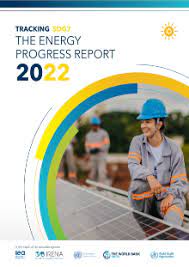Tracking SDG 7 – The Energy Progress Report 2022:

The Tracking SDG 7 – The Energy Progress Report 2022 was released which showed that the Russia-Ukraine war and Covid-19 crisis have considerably slowed down efforts towards attaining the Seventh Sustainable Development Goal (SDG 7) target.
- The Energy Progress Report is a product of close collaboration among the five SDG 7 custodian agencies in the form of a specially constituted Steering Group:
- International Energy Agency (IEA), International Renewable Energy Agency (IRENA), United Nations Statistics Division (UNSD), World Bank, World Health Organization (WHO).
- SDG 7 has a target of universal access to clean and affordable energy by 2030.
Findings:
Access to electricity (7.1):
- The share of the world’s population with access to electricity rose from 83% in 2010 to 91% in 2020, increasing the number of people with access by 1.3 billion globally.
- The number without access declined from 1.2 billion people in 2010 to 733 million in 2020.
- However, the pace of progress in electrification has slowed in recent years which may be explained by the increasing complexity of reaching more remote and poorer unserved populations and the unprecedented impact of the Covid-19 pandemic.
- At current rates of progress, the world will reach only 92% electrification by 2030.
Clean cooking (7.1):
- The share of the global population with access to clean cooking fuels and technologies rose to 69% in 2020, an increase of 3% points over last year 2021.
- However, population growth outpaced much of the gains in access, particularly in Sub-Saharan Africa.
- As a result, the total number of people lacking access to clean cooking has remained relatively stagnant for decades.
- The increase was primarily driven by advancements in access to large, populous countries in Asia.
Renewables (7.2):
- While the share of renewable capacity expansion rose by a record amount in 2021, the positive global and regional trajectories mask the fact that countries where new capacity additions lagged were those most in need of increased access.
- Moreover, rising commodity, energy and shipping prices, as well as restrictive trade measures, have increased the cost of producing and transporting solar photovoltaic (PV) modules, wind turbines, and biofuels, adding uncertainty for future renewable energy projects.
Energy efficiency (7.3):
- SDG 7.3 aims to double the global rate of annual improvement in primary energy intensity—the amount of energy used per unit of wealth created—to 2.6% in 2010–30 versus 1990–2010.
- From 2010 to 2019, global annual improvements in energy intensity averaged around 1.9%, well below the target.
International Financial Flows (7.A):
- International public financial flows to developing countries in support of clean energy decreased for the second year in a row, falling to USD 10.9 billion in 2019, despite the immense needs for sustainable development in most countries and growing urgency of climate change.
- Overall, the level of financing remains below what is needed to reach SDG 7, particularly in the most vulnerable and least developed countries.




